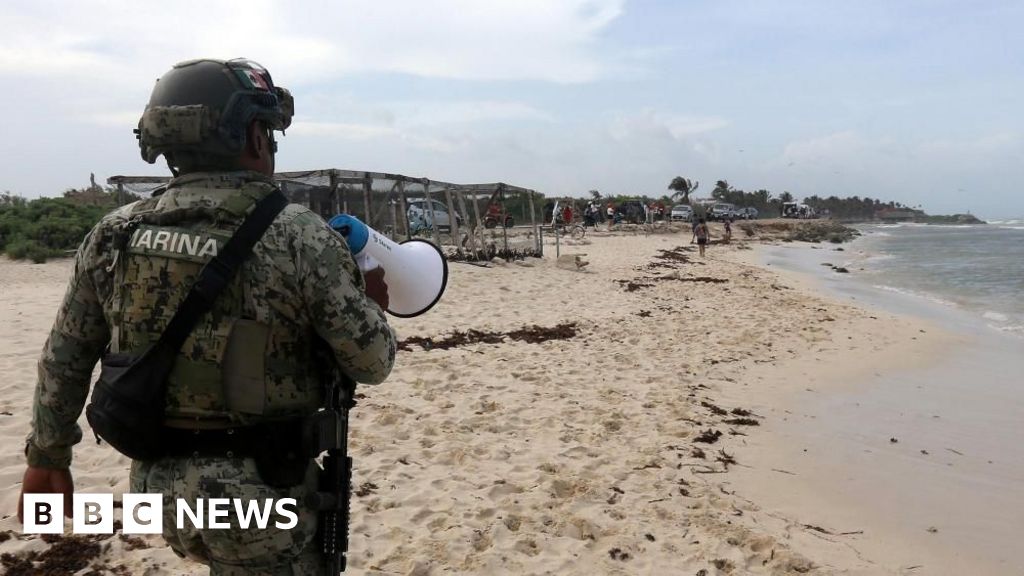A hurricane which has wreaked havoc across the Caribbean, destroying property and leaving homes without power, is about to make landfall on Mexico’s Yucatán Peninsula.
Hurricane Beryl, currently classed as category two, is set to hit the region’s coastline on Friday morning, affecting the area’s two million residents and the tourist hotspots of Cancún and Tulum.
Beaches are closed and thousands of troops have been deployed to help as the storm hits the country’s southeast shoreline.
The US National Hurricane Center (NHC) said hurricane conditions were “starting to occur” in the region, and warned people to take shelter.
- Author, Ian Aikman
- Role, BBC News
-
Across the Caribbean, at least ten people are known to have died and more are missing, roofs have been torn from buildings, and thousands of homes were left without power.
Mexican authorities have taken measures to prepare the coastline for the hurricane.
Schools have been closed, hotel windows have been boarded up, and emergency shelters have been set up for locals and tourists in areas facing the brunt of the impact.
Residents in Cancún have rushed to supermarkets to stock up on supplies, with some encountering empty shelves on their visits.
More than 8,000 troops from the army, air force and national guard have been deployed in the Yucatán Peninsula to provide support to the population.
Some were seen patrolling the beaches on Thursday, urging people to leave.
Hundreds of tourists have been evacuated from hotels across the peninsula’s coastline, and more than 3,000 people have fled from Holbox Island just off the Mexican coast, according to local authorities.
More than 300 flights have been cancelled or delayed.
Anita Luis, a tourist visiting Cancún from Dallas, Texas, told the Reuters news agency on Thursday: “We just want to go back home safely and pray the same for everybody else but we’re just stranded here.”
Meanwhile, Virginia Rebollar, a Mexican tourist who travelled to Tulum with three family members said: “They cancelled our flight and we had to pay for two extra nights.
“We have some fear, but we are convinced that people are prepared and know what to do,” she told the AFP news agency.
As well as leaving a trail of destruction in its wake, Hurricane Beryl has also broken records.
It is the first hurricane to reach the category four level in June since NHC records began and the earliest to hit category five – the highest category – in July.
Hurricane Beryl’s record-breaking nature has put the role of climate change in the spotlight.
The causes of individual storms are complex, making it difficult to fully attribute specific cases to climate change.
King Charles III said he had been “profoundly saddened” by the destruction the hurricane had caused in the Caribbean, impacting several Commonwealth islands.
The Royal Navy has sent an aid ship to the Cayman Islands to provide support to communities damaged by the hurricane on Thursday.
About 90% of homes were destroyed or severely damaged on Union Island, which is part of St Vincent and the Grenadines.
Where will Hurricane Beryl go next?
Beryl will weaken rapidly as it moves over land, when it is expected to be downgraded to a tropical storm, according to BBC Weather.
Despite this, up to 10 inches of rain could still fall, causing possible flash flooding.
It will then travel over the Gulf of Mexico on Friday evening, moving towards northeastern Mexico and southern Texas by the end of the weekend.
By the time it makes landfall on Sunday evening, the storm is expected to have strengthened back to a hurricane.
Texas Governor Greg Abbott told residents near the state’s Atlantic coast to “keep an eye on the gulf” and “have an emergency plan to take care of yourself and your loved ones”.
The US National Oceanic and Atmospheric Administration has warned that the North Atlantic could get as many as seven major hurricanes this year – up from an average of three in a season.
#Hurricane #Beryl #batters #Mexicos #Yucatán #Peninsula,
#Hurricane #Beryl #batters #Mexicos #Yucatán #Peninsula
